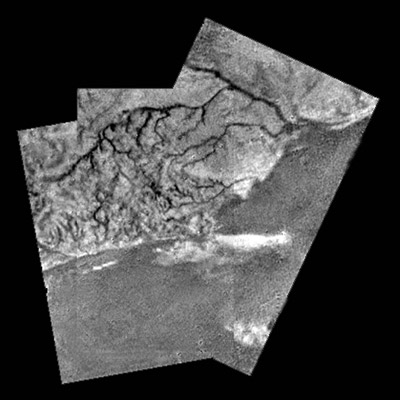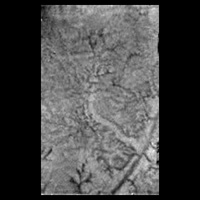

|
Korean Job Discussion Forums
"The Internet's Meeting Place for ESL/EFL Teachers from Around the World!"
|
| View previous topic :: View next topic |
| Author |
Message |
mithridates

Joined: 03 Mar 2003
Location: President's office, Korean Space Agency
|
 Posted: Fri Jan 21, 2005 5:41 pm Post subject: The Titan thread Posted: Fri Jan 21, 2005 5:41 pm Post subject: The Titan thread |
 |
|
The ESA has finally held its big news conference on the data they've gathered so far. I'm going to highlight the parts I think to be interesting in bold.

Mosaic of river channel and ridge area on Titan
On 14 January ESA's Huygens probe made an historic first ever descent to the surface of Titan, 1.2 billion kilometres from Earth and the largest of Saturn's moons. Huygens travelled to Titan as part of the joint ESA/NASA/ASI Cassini-Huygens mission. Starting at about 150 kilometres altitude, six multi-function instruments on board Huygens recorded data during the descent and on the surface. The first scientific assessments of Huygens' data were presented during a press conference at ESA head office in Paris on 21 January.
"We now have the key to understanding what shapes Titan's landscape," said Dr Martin Tomasko, Principal Investigator for the Descent Imager-Spectral Radiometer (DISR), adding: "Geological evidence for precipitation, erosion, mechanical abrasion and other fluvial activity says that the physical processes shaping Titan are much the same as those shaping Earth."
"Islands in the stream"... possible 'islands' on a dark plain
Spectacular images captured by the DISR reveal that Titan has extraordinarily Earth-like meteorology and geology. Images have shown a complex network of narrow drainage channels running from brighter highlands to lower, flatter, dark regions. These channels merge into river systems running into lakebeds featuring offshore 'islands' and 'shoals' remarkably similar to those on Earth.

"Islands in the stream"... possible 'islands' on a dark plain
Data provided in part by the Gas Chromatograph and Mass Spectrometer (GCMS) and Surface Science Package (SSP) support Dr Tomasko's conclusions. Huygens' data provide strong evidence for liquids flowing on Titan. However, the fluid involved is methane, a simple organic compound that can exist as a liquid or gas at Titan's sub-170��C temperatures, rather than water as on Earth.
Titan's rivers and lakes appear dry at the moment, but rain may have occurred not long ago.
Deceleration and penetration data provided by the SSP indicate that the material beneath the surface's crust has the consistency of loose sand, possibly the result of methane rain falling on the surface over eons, or the wicking of liquids from below towards the surface.
Heat generated by Huygens warmed the soil beneath the probe and both the GCMS and SSP detected bursts of methane gas boiled out of surface material, reinforcing methane's principal role in Titan's geology and atmospheric meteorology -- forming clouds and precipitation that erodes and abrades the surface.
In addition, DISR surface images show small rounded pebbles in a dry riverbed. Spectra measurements (colour) are consistent with a composition of dirty water ice rather than silicate rocks. However, these are rock-like solid at Titan's temperatures.

Two new Titan features - water ice and methane springs
Titan's soil appears to consist at least in part of precipitated deposits of the organic haze that shrouds the planet. This dark material settles out of the atmosphere. When washed off high elevations by methane rain, it concentrates at the bottom of the drainage channels and riverbeds contributing to the dark areas seen in DISR images.
New, stunning evidence based on finding atmospheric argon 40 indicates that Titan has experienced volcanic activity generating not lava, as on Earth, but water ice and ammonia.
Titan landing site seen from Cassini
Thus, while many of Earth's familiar geophysical processes occur on Titan, the chemistry involved is quite different. Instead of liquid water, Titan has liquid methane. Instead of silicate rocks, Titan has frozen water ice. Instead of dirt, Titan has hydrocarbon particles settling out of the atmosphere, and instead of lava, Titanian volcanoes spew very cold ice.
Titan is an extraordinary world having Earth-like geophysical processes operating on exotic materials in very alien conditions.
"We are really extremely excited about these results. The scientists have worked tirelessly for the whole week because the data they have received from Huygens are so thrilling. This is only the beginning, these data will live for many years to come and they will keep the scientists very very busy", said Jean-Pierre Lebreton, ESA's Huygens Project Scientist and Mission manager.
The Cassini-Huygens mission is a cooperation between NASA, ESA and ASI, the Italian space agency. The Jet Propulsion Laboratory (JPL), a division of the California Institute of Technology in Pasadena, is managing the mission for NASA's Office of Space Science, Washington DC. JPL designed, developed and assembled the Cassini orbiter while ESA operated the Huygens atmospheric probe.
Oh, and the next Titan flyby is in about 20 days. No more landings though... |
|
| Back to top |
|
 |
phaedrus

Joined: 13 Nov 2003
Location: I'm comin' to get ya.
|
 Posted: Fri Jan 21, 2005 6:43 pm Post subject: Posted: Fri Jan 21, 2005 6:43 pm Post subject: |
 |
|
Water rocks, ice volcanoes, methane rivers... cool.
It's too bad that non-carbon based life is a long shot, because it is neat to think about what kind of civilization or life forms could evolve on planets/moons similar to Titan. |
|
| Back to top |
|
 |
Manner of Speaking

Joined: 09 Jan 2003
|
 Posted: Fri Jan 21, 2005 10:31 pm Post subject: Posted: Fri Jan 21, 2005 10:31 pm Post subject: |
 |
|

This photo is amazing. If I didn't know better, I'd swear it came out of a first year university Physical Geography textbook. I've edited the image slightly and increased the contrast to bring out some interesting features:

Unfortunately the linear scale of the photo is't given, so the areal coverage could be a few square miles to several hundred. Still, if we assume the photo was taken while Hyugens was at least 1 to 2 kilometers up, it may cover an area of at least several hundred square miles.
At A, B, and C, three distinct drainage basins are apparent. A drains into a larger channel at upper right, B and C drain directly into what appears to be a body of liquid, some kind of "lake". All three exhibit the dendritic drainage pattern characteristic of fine, uniformly-grained soils on Earth.
At D, there appears to be a ridge or drainage divide separating the drainage basins at B and C; the upper reaches of channels B and C drain directly away from it, then turn right before they drain into the "lake".

What is really interesting, however, is that if you look at this photo as a stereopair, the ridge at D seems to continue all the way to the upper left at E, but is overlain in the center by the drainage basin at A. When a drainage channel "dissects" a ridge like this on Earth, it usually indicates that the drainage basin is OLDER than the underlying ridge. It's possible that the drainage basins in the photograph are very deep and stable, and have not changed their shape or direction for a very long time.
If we could stand on Titan and stand next to the shoreline of one of these channels, the surrounding landscape might resemble that of the Grand Canyon in the US.
At F and G there are indications of coastal erosion and wave activity. G appears to be a ridge which snakes down towards the big "lake", but is suddenly truncated perpendicularly by the white area at F. There could be a "beach" backed by cliffs along area F, but without knowing the scale of the photo, the cliffs could be only 1 meter to several hundred meters high.

If you look at this photo in a stereopair and look at area H VERY carefully, there appear to be currents or surface waves extending from the lower right and curving slightly to the upper left. If I didn't know better, this could be a photo of certain regions along the south shore of the Great Lakes. Incredible.
Last edited by Manner of Speaking on Sat Jan 22, 2005 10:07 pm; edited 1 time in total |
|
| Back to top |
|
 |
mithridates

Joined: 03 Mar 2003
Location: President's office, Korean Space Agency
|
 Posted: Sat Jan 22, 2005 4:19 am Post subject: Posted: Sat Jan 22, 2005 4:19 am Post subject: |
 |
|
 I need to learn to analyze pictures like you. I'll teach you hanja if you teach me how. I need to learn to analyze pictures like you. I'll teach you hanja if you teach me how.
Here's a composite of pictures from 10 km up if that helps...
 |
|
| Back to top |
|
 |
VanIslander

Joined: 18 Aug 2003
Location: Geoje, Hadong, Tongyeong,... now in a small coastal island town outside Gyeongsangnamdo!
|
 Posted: Sat Jan 22, 2005 2:57 pm Post subject: Posted: Sat Jan 22, 2005 2:57 pm Post subject: |
 |
|
| phaedrus wrote: |
| It's too bad that non-carbon based life is a long shot, because it is neat to think about what kind of civilization or life forms could evolve on planets/moons similar to Titan. |
We are carbon-based life forms. So go on and think. |
|
| Back to top |
|
 |
phaedrus

Joined: 13 Nov 2003
Location: I'm comin' to get ya.
|
 Posted: Sat Jan 22, 2005 4:15 pm Post subject: Posted: Sat Jan 22, 2005 4:15 pm Post subject: |
 |
|
| VanIslander wrote: |
| phaedrus wrote: |
| It's too bad that non-carbon based life is a long shot, because it is neat to think about what kind of civilization or life forms could evolve on planets/moons similar to Titan. |
We are carbon-based life forms. So go on and think. |
Yeah, I know. It's unlikely carbon and water based life could survive somewhere such as Titan, so it is neat to think that in places such as this alternative life forms might evolve. Silicon and ammonia are possibilities, but unlikely ones.
http://en.wikipedia.org/wiki/Extraterrestrial_life
In the end non-carbon life seems improbable. |
|
| Back to top |
|
 |
mithridates

Joined: 03 Mar 2003
Location: President's office, Korean Space Agency
|
 Posted: Sat Jan 22, 2005 4:38 pm Post subject: Posted: Sat Jan 22, 2005 4:38 pm Post subject: |
 |
|
Here's an article from November 2004:
| Quote: |
Water is not an essential ingredient for Life, scientists now claim
Billions of dollars are pumped into extraterrestrial exploration each year in the search for the ultimate prize - the discovery of life on other planets. But are we looking in all the right places? Prof Steven A Benner, who is working with NASA on the design of the next generation of Mars probes, believes that life could flourish without any need for water. In the December issue of Current Opinion in Chemical Biology, he and his colleagues at the University of Florida describe how organisms could survive in exotic environments such as on Saturn's moon Titan.
Benner and colleagues identify just two absolute requirements for life to exist: a suitable temperature range to allow chemical bonding, and an energy source (for example, the sun or radioactive decay). This contrasts with the common belief that life absolutely requires liquid water. Indeed, the authors speculate on the possibilities of life emerging in cold, icy environments, just like that of Titan, which meets both requirements and many 'weaker' ones. "Life may even exist in more exotic environments, such as the supercritical dihydrogen-helium mixtures found on gas giants," speculates Prof Benner, referring to the large gaseous planets such as Jupiter and Saturn. He even wonders if we may have missed exotic forms of life here on Earth. "This question is not as absurd as it might seem," says Benner. "Just 50 years ago...life in the deep ocean was not known."
Titan, currently being studied by the Cassini space probe, is perhaps an ideal place to look for life. The stunning pictures and data already sent back from the moon suggest a world of yellow clouds and oily black methane lakes, an environment that is thought to resemble that of the Earth billions of years ago. This puzzling moon is too cold for large quantities of liquid water to exist, however, which for many probably rules out life. Humans and, indeed, simple bacteria are mostly made up of water, so it is difficult to envisage life without it. But Benner believes this focus on water can blinker the search. "Why not use the hydrocarbons that are naturally liquid on Titan as a solvent for life directly?," he muses. "In many senses, hydrocarbon solvents are better than water for managing complex organic chemical reactivity."
We will soon know more. Next month, the European-built Huygens probe will detach from Cassini and touch down, or perhaps splash down, on Titan's surface. "The Huygens mission will be the first real input into this field for some time. Its potential for providing an 'Aha!' experience with respect to weird life is enormous," says Benner.
All life on Earth is widely supposed to have descended from a common ancestor. One consequence of this is that every organism uses the same general biochemistry. For example, all forms of life make use of proteins made from the same set of building blocks. But this may not be the only way to do things. Could creatures exist elsewhere in the Universe with a completely different biochemistry? Experiments in recent years have partly addressed such questions by re-engineering protein and DNA systems. For example, alternative amino acids to those found in living systems are capable of standing in for their natural counterparts. Professor Benner and colleagues now provide a wide-ranging exploration of just how far the chemistry of life can be pushed. "Is water necessary? Is carbon essential? Why not silicon?," asks Benner. One of the leading theories on the origins of life supposes that the earliest organisms used RNA instead of DNA to pass on their genetic information and to catalyse reactions. If this is correct, it demonstrates that alternative biochemistries are indeed possible. Benner suggests that 'RNA organisms' might still exist. Because such life forms would not need the biochemical machinery to produce proteins, they would be much smaller than bacteria, hinting at possible environments we might look for them in. "Many minerals have pores that are smaller than one micron across. These might hold smaller RNA organisms," says Benner.
While more exotic worlds might well harbour life, Mars remains the best bet. "There was water on Mars when there was life on Earth," Benner points out. "This would not be particularly weird life, of course, in that it would be living in water, but it could easily be weird by Earth standards." However, Benner concedes that "a simple 'We don't know' is often the best answer for some questions. "Until life is encountered elsewhere, or aliens contact us, we will not have an independent second dataset. We may not even then, if the alien life itself shares an ancestor with life on Earth." |
|
|
| Back to top |
|
 |
Manner of Speaking

Joined: 09 Jan 2003
|
 Posted: Sat Jan 22, 2005 9:59 pm Post subject: Posted: Sat Jan 22, 2005 9:59 pm Post subject: |
 |
|
| mithridates wrote: |
 I need to learn to analyze pictures like you. I'll teach you hanja if you teach me how. I need to learn to analyze pictures like you. I'll teach you hanja if you teach me how.
|
Deal. Speak Korean with me, and that'll be enough.  |
|
| Back to top |
|
 |
funplanet

Joined: 20 Jun 2003
Location: The new Bucheon!
|
 Posted: Mon Jan 24, 2005 5:16 am Post subject: Posted: Mon Jan 24, 2005 5:16 am Post subject: |
 |
|
who knows, life may very well exist....scientists were shocked to learn that life existed around the vents deep in the ocean and found the first chemical life-forms, er..not needing oxygen, light, etc...they fed on the high concentrations of chemicals that were pouring out of the vents...
why not methane-gobbling organisms?
anyway, great thread...keep it up! |
|
| Back to top |
|
 |
mithridates

Joined: 03 Mar 2003
Location: President's office, Korean Space Agency
|
 Posted: Mon Jan 24, 2005 5:37 am Post subject: Posted: Mon Jan 24, 2005 5:37 am Post subject: |
 |
|
That's why NASA and myself are excited about the next probe to be sent to Europa, one that will orbit the moon for a while and check things out, and perhaps a lander that will go underneath the ice to swim around and look for things. Europa's interesting because it's a big ocean covered with a large layer of ice a number of km thick. Underneath that the ocean is protected from radiation, has a relatively stable and warm temperature from the core of the moon, and I think there's a great chance life could exist there. There could be anything. I think it would be amazing if we sent the probe down there, it began swimming around and then the last image we get is of the giant gaping maw of some gigantic sea creature... 
That's one of the reasons why I hope China and India have about the same economic success as the US. I don't care so much about which nation becomes a superpower but I'd love to see a space race again. I don't want to see the US bearing the burden of space travel alone.
| Quote: |
From Europa to Sedna: Life Beneath the Ice in the Outer Solar System?
At present, we know of no worlds beyond our Earth where life exists. However, primitive organisms on our planet have evolved and adapted over billions of years, colonising the most inhospitable places.
Since life seems to gain a foothold in the most hostile environments, it seems distinctly possible that living organisms could exist in ice-covered oceans on worlds far from the Sun, according to Dr. David Rothery (Open University), who will be speaking today at the RAS National Astronomy Meeting in Milton Keynes.
Europa is the innermost of Jupiter's large icy satellites. It is slightly smaller than our own Moon, but its rocky interior is hidden beneath a 100 km blanket of ice. There has been much speculation as to whether the ice remains solid right down to the moon's rocky interior, or whether it consists of a thinner ice sheet floating on an ocean of water.
Data from NASA's Galileo spacecraft, which orbited Jupiter from 1995 until 2003, provided detailed insights into Europa's structure that will not be surpassed until the arrival of NASA's Jupiter Icy Moons Orbiter (which may not be until 2023).
The high-resolution Galileo images and other data revolutionised our knowledge of Europa's surface and interior structure, making it seem more likely that the ice is (at least at some times and in some places) relatively thin (much less than 10 km) and overlying a liquid water ocean. The images showed localized areas of 'melt-through' demonstrated by 'chaos' regions, where detached rafts of the icy shell can be seen dispersed in a now-refrozen matrix.
The cause of melt-through is likely to be tidal heating, which is especially strong within Europa because it orbits within the immense gravity of Jupiter and experiences competing tidal pulls from the large, neighbouring moons, Io and Ganymede. This process also powers the widespread volcanic eruptions on Io.
There may be occasional volcanic eruptions onto Europa's ocean floor - rather like a less active, ice-covered version of Io - or, more likely, hot springs where chemically-enriched water heated by passage through the rock re-emerges on the ocean floor.
This sort of environment is currently regarded as the most likely place for life on Earth to have begun, and life on Europa could have arisen in just the same way. If so, life could survive there today, supported by chemical energy in the same way that the 'hydrothermal vents' on Earth's ocean floors support ecosystems that do not depend on sunlight.
"Episodes of tidal heating in some of the Solar System's other icy bodies could equally well have given rise to life, even in such remote bodies as the newly discovered, remote planetoid Sedna if, as has been suggested, it has a satellite with which to interact tidally," said Dr. Rothery. "However, only in the case of Europa, and perhaps a few other satellites of the giant planets, does it seem plausible that life could flourish in the long term." |
|
|
| Back to top |
|
 |
Manner of Speaking

Joined: 09 Jan 2003
|
 Posted: Sun Sep 18, 2005 11:24 am Post subject: Posted: Sun Sep 18, 2005 11:24 am Post subject: |
 |
|
Shoreline Spotted on Saturn's Moon Titan

By Robert Roy Britt
Senior Science Writer
posted: 17 September 2005
02:02 pm ET
The idea of a large sea on Saturn's moon Titan was all but ruled out after the Cassini mission found no evidence early in its mission. But a new image shows what scientists think is a shoreline with bays and channels feeding liquid into a possible sea.
Scientists have long speculated that Titan might contain liquid methane or other hydrocarbons. The chemistry resembles prebiotic Earth, but Titan lacks liquid water. Nonetheless, earlier this month another group of researchers speculated that Titan might actually harbor life today. "This radar data is among the most telling evidence so far for a shoreline," said Steve Wall, radar deputy team leader from NASA's Jet Propulsion Laboratory, Pasadena, Calif.
The image, released Friday, shows a distinct division between a bright and apparently rough region and and dark and smooth area. "This is the area where liquid or a wet surface has most likely been present, now or in the recent past," Wall said. "Titan probably has episodic periods of rainfall or massive seepages of liquid from the ground."
"We also see a network of channels that run across the bright terrain, indicating that fluids, probably liquid hydrocarbons, have flowed across this region," said Dr. Ellen Stofan, Cassini associate radar team member from Proxemy Research in Laytonsville, Md.
Combined with other radar images taken on previous Cassini passes of Titan, scientists have identified two distinct types of drainage features. One type is long and deep, suggesting fluids flowing over long distances. Another is in a denser network that suggests rainfall. "It looks as though fluid flowed in these channels, cutting deeply into the icy crust of Titan," said Larry Soderblom with the U.S. Geological Survey in Flagstaff, Ariz. "Some of the channels extend over 100 kilometers [60 miles]. Some of them may have been fed by springs, while others are more complicated networks that were likely filled by rainfall."
More imaging is planned on future passes by the icy moon.
http://www.space.com/scienceastronomy/050917_titan_shore.html |
|
| Back to top |
|
 |
Manner of Speaking

Joined: 09 Jan 2003
|
 Posted: Sun Sep 18, 2005 11:37 am Post subject: Posted: Sun Sep 18, 2005 11:37 am Post subject: |
 |
|
Scientists Reconsider Habitability of Saturn's Moon

By Ker Than
Staff Writer
posted: 13 September 2005
06:25 am ET
Recent findings from NASA's Cassini spacecraft and new discoveries about organisms here on Earth that thrive in extreme conditions are causing scientists to rethink the possibility that there may be life on Saturn's cloudy moon Titan. Analyzing data from Cassini's recent Titan flybys, scientists at the Southwestern Research Institute (SwRI) in Texas and Washington State University announced last week that several of the key elements crucial for life on Earth are also present on Titan, including liquid reservoirs, organic molecules and ample energy sources.
Discovered in 1655 by a Dutch astronomer, Titan is the second largest moon in the solar system apart from Jupiter's Ganymede. Looking around, a person standing on Titan's surface would see rocky fields strewn with small ice pebbles. Gazing up, one would see clouds racing across the orange Titan sky as if on fast forward, because like Venus, Titan's atmosphere rotates much faster than its surface. Saturn and its magnificent rings would not be visible most of the time, due to the dense haze of orange smog that blankets the entire moon.
Scientists are interested in Titan because it reminds them of how Earth was billions of years before life existed. Titan is colder (-289 degrees Fahrenheit, or –178 Celsius) than primitive Earth was, but it has a dense nitrogen-rich atmosphere and a natural process for producing hydrogen and carbon containing molecules called hydrocarbons that are essential for life on Earth. Astronomers have long seen Titan as a place that had the preconditions for life, but most scientists saw it as too inhospitable to actually contain biology today.
The Sun's ultraviolet light reacts with nitrogen and methane high in the upper reaches of Titan's atmosphere, producing the orange smog and a steady stream of organic materials that fall steadily onto the moon's surface. Many of the natural forces that shape the Earth's landscape are also active on Titan, including shifting continental plates, wind erosion, possibly oceans—albeit of ethane and methane and not water—and volcanoes. On Earth, these forces raise mountains and carve canyons, yet much of Titan's surface looks smooth, leading many scientists to suspect that the moon is relatively young.
If life does exist on Titan, a good place to look for it may be in hot springs connected to hydrocarbon reservoirs, said David Grinspoon, a researcher at SwRI's Space Science and Engineering Division.
Further fueling speculations about life on Titan are recent findings that microscopic organisms that live in extreme environments on Earth are hardier and capable of surviving in environments much harsher than anyone ever imagined. One recently discovered species of so-called extremophiles could live in briny environments ten times saltier than seawater. Another species found in Yellowstone National Park could live off nothing but hydrogen, the most abundant element in the universe.
Perhaps most relevant for life on Titan, scientists have discovered within the past two decades several species of bacteria that thrive in freezing temperatures. Called psychrophiles, these organisms live in temperatures ranging from 23 to 68 degrees Fahrenheit (-5 to 20 degrees Celsius) and use methane to produce energy.
Scientists knew that if life did exist on Titan, it might need to have a combination of these traits, so the discovery that such life actually does exists is highly encouraging. Grinspoon speculated that life on Titan, if there is any, might be able to produce energy by mixing acetylene, a hydrocarbon abundant in Titan's atmosphere, with hydrogen. The energy could then be harnessed to power metabolism or to heat their surroundings.
"In environments that are energy-rich but liquid-poor, like near the surface of Titan, natural selection may favor organisms that use their metabolic heat to melt their own watering holes," Grinspoon said.
The researchers presented their ideas Sept. 8 at the 2005 Meeting for the American Astronomical Society's Division for Planetary Sciences.
http://www.space.com/scienceastronomy/050913_titan_life.html |
|
| Back to top |
|
 |
Bulsajo

Joined: 16 Jan 2003
|
|
| Back to top |
|
 |
yoda

Joined: 19 Jan 2003
Location: Incheon, South Korea
|
 Posted: Sun Sep 18, 2005 3:15 pm Post subject: Posted: Sun Sep 18, 2005 3:15 pm Post subject: |
 |
|
As far as exploring Europa is concerned, the Earth has a great spot to test techniques and equipment. Under 4 km of Antarctic ice lies Lake Vostok, which until now has never been explored (or even seen) by humans. For those interested in finding new life, Lake Vostok may not hold new life, but instead very old life. The lake has essentially been cut off from the rest of the world for something like 20 million years. The microbes there are probably remnants from a time when Antarctica was green.
One Lake Vostok Article
But the idea of drilling a whole through the ice and then using ice hocky puck sized transmitters to relay data back through the ice as holes behind the driller freeze up to prevent contamination is an idea that may be useful in both environments. |
|
| Back to top |
|
 |
joe_doufu

Joined: 09 May 2005
Location: Elsewhere
|
 Posted: Mon Sep 19, 2005 2:45 am Post subject: Posted: Mon Sep 19, 2005 2:45 am Post subject: |
 |
|
| phaedrus wrote: |
| non-carbon life seems improbable. |
All life seems improbable, if you consider the amazing series of events that must have occurred for life to begin. OTOH life seems extremely probable, if you consider the enormity of a planet, the vastness of the universe, and the unbelievable expansiveness of time. Nobody knows how probable life is. Who are you to make such a declaration? |
|
| Back to top |
|
 |
|
|
You cannot post new topics in this forum
You cannot reply to topics in this forum
You cannot edit your posts in this forum
You cannot delete your posts in this forum
You cannot vote in polls in this forum
|
|

